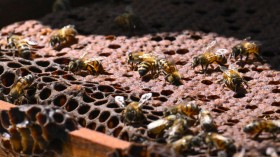Since 2011, scientists have been puzzling over possible water-related streaks seen on the surface of Mars. These recurring slope lineae (RSL) appear annually on steep slopes, such as crater walls, and could indicate the movement of water across the surface of the planet.
Lujendra Ojha, a Georgia Institute of Technology Ph.D. candidate, discovered them while an undergraduate at the University of Arizona. More recently, he worked with Georgia Tech assistant professor James Wray, using a Compact Reconnaissance Imaging Spectrometer for Mars (CRISM) to study 13 confirmed RSL sites. No spectral signature revealing water or salts was found, but they did find evidence of ferric and ferrous minerals.
"We still don't have a smoking gun for existence of water in RSL, although we're not sure how this process would take place without water," said Ojha. "Just like the RSL themselves, the strength of the spectral signatures varies according to the seasons. The signatures are stronger when it's warmer and less significant when it's colder."
By the time the team can observe the planet's surface it is mid-afternoon, meaning the water and potential hydrated salts present in RSL may have dried considerably given the harsh Martian atmosphere.
Ojha, Wray and several Arizona-based colleagues looked at every image gathered by the High Resolution Imaging Science Experiment (HiRISE) from March to October of 2011. Observing areas near the southern mid-latitudes on rocky cliffs, they found 200 locations that were ideal for RSL.
"Only 13 of the 200 locations had confirmed RSL," said Ojha. "There were significant differences in abundance and size between sites, indicating that additional unknown factors such as availability of water or salts may play a crucial role in RSL formation."
"Comparing their new observations with images taken in previous years, the team also found that RSL are much more abundant some years than others. Water on Mars today seems elusive at best - there one year, gone the next," said the press release announcing the findings.
The findings were published in Geophysical Research Letters.
© 2024 NatureWorldNews.com All rights reserved. Do not reproduce without permission.





